Comparison Between the Efficacies of Amlodipine and Cilnidipine in Treating Hypertensive Patients
Article Information
Md. Hasibul Hasan*
Consultant, Department of Cardiology, Mugda Medical College Hospital, Dhaka, Bangladesh
*Corresponding author: Md. Hasibul Hasan, Junior Consultant, Department of Cardiology, Mugda Medical College Hospital, Dhaka, Bangladesh.
Received: 16 October 2023; Accepted: 25 October 2023; Published: 09 January 2024
Citation:
Md. Hasibul Hasan. Comparison Between the Efficacies of Amlodipine and Cilnidipine in Treating Hypertensive Patients. Cardiology and Cardiovascular Medicine. 8 (2024): 1-6.
View / Download Pdf Share at FacebookAbstract
Background: Amlodipine and cilnidipine, both Calcium Channel Blockers (CCBs), possess distinct pharmacokinetic and pharmacodynamic properties. Yet, there's a notable lack of comprehensive research on their effectiveness in treating hypertension. This gap hinders our understanding of their therapeutic potential and comparative efficacy.
Aim of the study: The aim of the study was to compare the efficacies of amlodipine and cilnidipine in treating hypertensive patients.
Methods: This cross-sectional observational study was conducted at the Department of Cardiology, Mugda Medical College & Hospital, Dhaka, Bangladesh, spanning from January 2021 to December 2021. The study enrolled 140 diagnosed hypertensive patients, aged 20 to 65, of both genders. Patients were divided into two groups: Amlodipine (70 patients) and Cilnidipine (70 patients). Random sampling was employed for sample selection, and data were collected using a semi-structured predesigned questionnaire. Data analysis utilized MS Office tools and SPSS Version 23.0. Results: Over 8 weeks, Amlodipine decreased mean systolic blood pressure (SBP) from 151.26 to 133.12 and diastolic blood pressure (DBP) from 95.9 to 86.3. Similarly, Cilnidipine lowered mean SBP from 149.25 to 130.09 and DBP from 94.11 to 84.86. Both drugs had minimal impact on pulse rate. Amlodipine reduced mean pulse rate from 74.74 to 74.02 and Cilnidipine reduced from 76.8 to 75.43.
Conclusion: Both Amlodipine and Cilnidipine are effective drugs for controlling systolic and diastolic blood pressure. However, in addition to blood pressure control, Cilnidipine exhibits a slight advantage over Amlodipine in reducing heart rate and pulse rate.
Keywords
Hypertension; Amlodipine; Cilnidipine; Systolic blood pressure; Diastolic blood pressure
Hypertension articles; Amlodipine articles; Cilnidipine articles; Systolic blood pressure articles; Diastolic blood pressure articles
Article Details
Introduction
Hypertension (HTN) is one of the most common diseases afflicting humans worldwide, and its associated morbidity, mortality, and societal costs make it a significant public health challenge [1]. HTN is typically defined as the level of blood pressure (BP) at which the initiation of therapy reduces BP-related health problems and death [2]. Hospital-based studies in various regions, such as Addis Ababa, have shown that cardiovascular diseases (CVD), including HTN, contribute significantly to mortality rates [3]. Consequently, addressing CVD and its risk factors, particularly HTN, is a current healthcare priority. HTN is classified as mild (Stage/Grade 1, systolic BP between 140- and 159-mm Hg), moderate (Stage/Grade 2, systolic BP between 160- and 179-mm Hg and diastolic BP between 100- and 109-mm Hg), and severe (Stage/Grade 3, systolic BP ≥180 mm Hg, diastolic BP ≥110 mm Hg) [4]. If HTN is not effectively managed, it significantly increases the risk of various cardiovascular conditions, including coronary heart disease, congestive heart failure, ischemic and hemorrhagic stroke, renal failure, and peripheral arterial disease [5,6]. A substantial body of research in the literature emphasizes the importance of rigorous BP monitoring and control to achieve the greatest possible reduction in clinical cardiovascular events. A recent study demonstrated that a reduction in average diastolic blood pressure (DBP) of approximately 2 mmHg leads to a 14% decrease in the risk of stroke and ischemic events. Additionally, the risk of coronary artery disease was concurrently reduced by 6% [7]. Lowering blood pressure has also shown benefits in various other studies [8]. In clinical practice, several classes of antihypertensive medications are used, including diuretics, α-blockers, β-blockers, angiotensin-converting enzyme inhibitors, angiotensin receptor blockers, and organic calcium channel blockers (CCBs) [9]. These medications are employed individually or in combination to manage hypertension and various heart conditions. Amlodipine, a CCB, stands out due to its remarkable pharmacokinetic and pharmacodynamic profile. However, one notable side effect associated with amlodipine is peripheral edema, which can affect up to 30% of hypertensive patients taking the medication. In contrast, cilnidipine, a newer generation of CCB, is known for its ability to inhibit sympathomimetic activity [10]. This study aimed to compare the efficacies of amlodipine and cilnidipine in treating hypertensive patients.
Methodology
This cross-sectional observational study was conducted at the Department of Cardiology, Mugda Medical College & Hospital, Dhaka, Bangladesh, spanning from January 2021 to December 2021. The study enrolled 140 diagnosed hypertensive patients, aged 20 to 65, of both genders. All patients were divided into two groups using a random sampling technique. In the Amlodipine group, 70 patients orally took amlodipine at doses of 5-10 mg per day, while in the Cilnidipine group, 70 patients orally took cilnidipine at doses of 10-20 mg per day as part of the hypertension treatment protocol. Properly written consent was obtained from all the patients before data collection. A thorough physical and systemic examination was performed, including radial pulse and blood pressure measurements in an upright position using a mercury sphygmomanometer. Mean systolic and diastolic blood pressure values were recorded. Additionally, routine tests such as complete blood count, random blood glucose, liver function, renal function, lipid profiles, and urine routines were conducted before and after therapy in the hospital laboratory. Exclusion criteria encompassed age <20 years and >65 years, severe hepatic, renal, or cardiac diseases, pregnancy or lactation, major depressive disorder with psychotic symptoms, and medication use with known interactions. Demographic and clinical data were documented and analyzed using MS Office tools and SPSS version 23.0. A significance level of P < 0.05 was employed for statistical analysis.
Results
In this study involving 140 patients, the demographic characteristics of two groups, one taking Amlodipine and the other taking Cilnidipine, were analyzed. The mean age in both groups was similar, with Amlodipine group patients averaging 56.84 years and those in the Cilnidipine group averaging 57.34 years. Gender distribution showed a fairly balanced representation in both groups, with slightly more males. The prevalence of diabetes, dyslipidemia, and a family history of CORONARY ARTERY DISEASE (CAD) varied between the groups but without significant differences. The severity grades of hypertension in this study's patients taking Amlodipine and Cilnidipine were assessed. Among those on Amlodipine, 52.86% had mild hypertension, while 47.14% had moderate hypertension. Similarly, in the Cilnidipine group, 55.71% had mild hypertension, and 44.29% had moderate hypertension. At the beginning, Amlodipine group patients had a mean systolic blood pressure (SBP) of 151.26 (SD: 10.21), while Cilnidipine group patients had a mean SBP of 149.25 (SD: 12.57). Both drugs consistently lowered SBP over time. By week 2, Amlodipine's mean SBP was 145.14 (SD: 8.34), and Cilnidipine's was 144.10 (SD: 10.57). At week 4, Amlodipine had a mean SBP of 139.00 (SD: 6.07), and Cilnidipine had a mean SBP of 136.18 (SD: 7.76). Finally, by week 8, Amlodipine showed a mean SBP of 133.12 (SD: 4.91), and Cilnidipine had a mean SBP of 130.09 (SD: 6.02). These findings suggest both drugs effectively lower SBP in hypertension management, with Cilnidipine generally showing slightly lower SBP values. On the other hand, at baseline, Amlodipine group patients had a mean DBP of 95.9 (SD: 5.7), while Cilnidipine group patients had a mean DBP of 94.11 (SD: 6.76). At week 2, Amlodipine showed a mean DBP of 99.2 (SD: 4.09), whereas Cilnidipine exhibited a significantly lower mean DBP of 89.79 (SD: 4.06). By week 4, both medications demonstrated similar mean DBP values, with Amlodipine at 86.3 (SD: 2.93) and Cilnidipine at 86.12 (SD: 2.74). Finally, at week 8, Amlodipine displayed a mean DBP of 83 (SD: 2.55), while Cilnidipine had a mean DBP of 84.86 (SD: 1.79). Overall, the data suggests that both Amlodipine and Cilnidipine effectively reduce DBP in patients, with some fluctuations in their comparative efficacy over the weeks. In our study, at baseline, the mean heart rate for the Amlodipine group was 78.28 beats per minute (bpm), while the Cilnidipine group had a slightly lower mean heart rate of 78.16 bpm. After 8 weeks of treatment, the heart rate decreased in both groups, with the Amlodipine group showing a mean heart rate of 75.86 bpm, and the Cilnidipine group having a mean heart rate of 75.44 bpm. In terms of pulse rate, at baseline, the Amlodipine group had a mean pulse rate of 74.74 bpm, while the Cilnidipine group had a slightly higher mean pulse rate of 76.8 bpm. After 8 weeks of treatment, both groups experienced a decrease in pulse rate. The Amlodipine group had a mean pulse rate of 74.02 bpm, and the Cilnidipine group had a mean pulse rate of 75.43 bpm. These results suggest that both Amlodipine and Cilnidipine effectively contributed to the reduction of heart rate and pulse rate in hypertensive patients over the 8-week study period.
|
Variables |
Groups |
||||
|
Amlodipine |
Cilnidipine |
||||
|
(n=70) |
(n=70) |
||||
|
n |
% |
n |
% |
||
|
Age (Year) |
Mean ±SD |
56.84 ±9.21 |
57.34 ±9.44 |
||
|
Gender |
Male |
43 |
61.43% |
45 |
64.29% |
|
Female |
27 |
38.57% |
25 |
35.71% |
|
|
Diabetic |
DM |
24 |
34.29% |
23 |
32.86% |
|
Non-DM |
46 |
65.71% |
47 |
67.14% |
|
|
Dyslipidemia |
Present |
25 |
35.71% |
24 |
34.29% |
|
Absent |
45 |
64.29% |
46 |
65.71% |
|
|
Family history of CAD |
Present |
14 |
20.00% |
12 |
17.14% |
|
Absent |
56 |
80.00% |
58 |
82.86% |
|
Table 1: Demographic status of patients. (N=140).
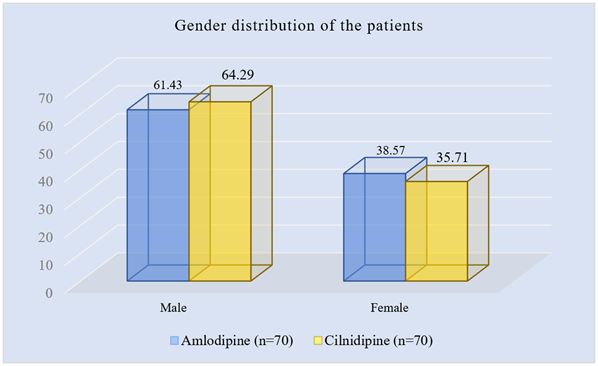
Figure 1: Column chart showed gender wise patients distribution. (N=140).
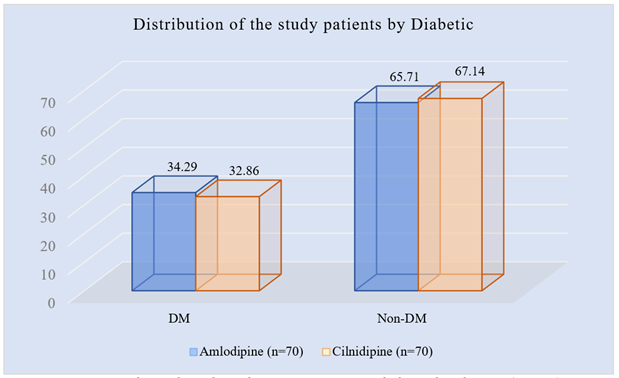
Figure 2: Column chart showed group wise patients diabetic distribution. (N=140).
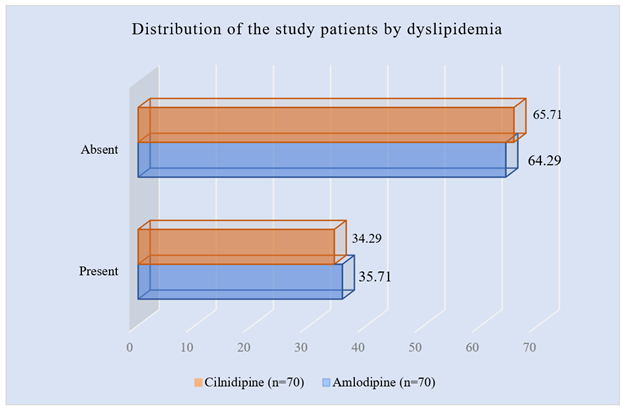
Figure 3: Bar chart showed group wise patients dyslipidemia distribution. (N=140).
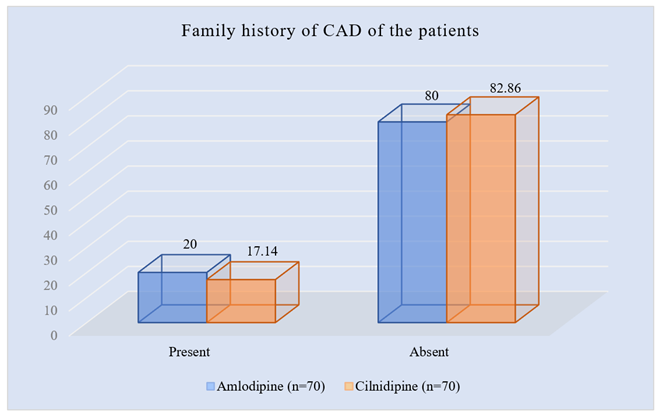
Figure 4: Column chart showed group wise patients family history of CAD. (N=140).
|
Severity |
Amlodipine |
Cilnidipine |
||
|
(n=70) |
(n=70) |
|||
|
n |
% |
n |
% |
|
|
Mild |
37 |
52.86% |
39 |
55.71% |
|
Moderate |
33 |
47.14% |
31 |
44.29% |
Table 2: Severity grade of hypertension of patients.(N=140).
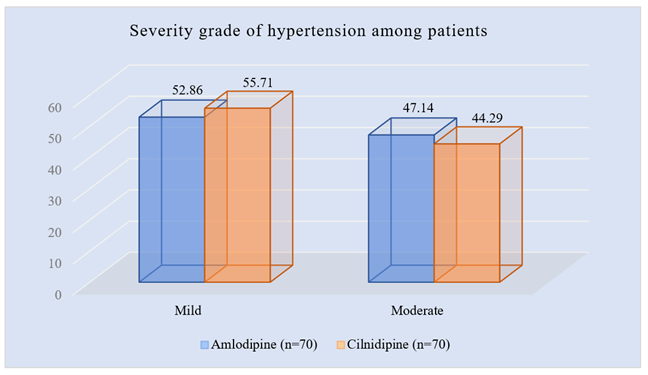
Figure 5: Column chart showed severity grade of hypertension of the patients. (N=140).
|
Instance (weeks) |
Amlodipine |
Cilnidipine |
||
|
Mean SBP |
SD |
Mean SBP |
SD |
|
|
Baseline |
151.26 |
10.21 |
149.25 |
12.57 |
|
2 |
145.14 |
8.34 |
144.10 |
10.57 |
|
4 |
139.00 |
6.07 |
136.18 |
7.76 |
|
8 |
133.12 |
4.91 |
130.09 |
6.02 |
Table 3: Comparison of efficacies in reducing SBP of patients. (N=140).
|
Instance (weeks) |
Amlodipine |
Cilnidipine |
||
|
Mean DBP |
SD |
Mean DBP |
SD |
|
|
Baseline |
95.9 |
5.7 |
94.11 |
6.76 |
|
2 |
99.2 |
4.09 |
89.79 |
4.06 |
|
4 |
86.3 |
2.93 |
86.12 |
2.74 |
|
8 |
83 |
2.55 |
84.86 |
1.79 |
Table 4: Comparison of efficacies in reducing DBP of patients. (N=140)
|
Variables |
Amlodipine group |
Cilnidipine group |
|
Heart rate |
||
|
At baseline mean |
78.28 |
78.16 |
|
8 weeks mean |
75.86 |
75.44 |
|
Pulse rate |
||
|
At baseline mean |
74.74 |
76.8 |
|
8 weeks mean |
74.02 |
75.43 |
Table 5: Heart and pulse rate reduction of patients. (N=140).
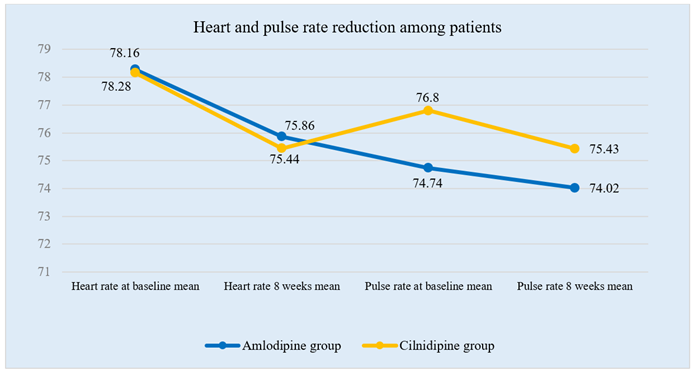
Figure 6: Line chart showed Heart and pulse rate reduction of the patients. (N=140)
Discussion
This study aimed to compare the efficacies of amlodipine and cilnidipine in treating hypertensive patients. In our study, the gender distribution was fairly balanced in both groups, with slightly more males. However, it's worth noting that in some other studies, female sex has commonly been reported as dominating. [11,12] In this study, the severity of hypertension in patients taking Amlodipine and Cilnidipine was assessed. Among those on Amlodipine, 52.86% had mild hypertension, and 47.14% had moderate hypertension. Similarly, in the Cilnidipine group, 55.71% had mild hypertension, and 44.29% had moderate hypertension. Hypertension (HTN) is categorized into different stages and grades based on blood pressure measurements. Stage 1 or mild HTN is defined as having a systolic blood pressure between 140 and 159 mmHg [4]. Stage 2 or moderate HTN is characterized by a systolic blood pressure between 160 and 179 mmHg and a diastolic blood pressure between 100 and 109 mmHg. Stage 3 or severe HTN is diagnosed when the systolic blood pressure is equal to or greater than 180 mmHg, and the diastolic blood pressure is equal to or greater than 110 mmHg. These classifications help healthcare professionals determine the severity of hypertension and guide appropriate treatment strategies. In our study, at the start, the Amlodipine group had a mean SBP of 151.26 (SD: 10.21), and the Cilnidipine group had a mean SBP of 149.25 (SD: 12.57). Both drugs consistently lowered SBP over time. By week 2, Amlodipine's mean SBP was 145.14 (SD: 8.34), and Cilnidipine's was 144.10 (SD: 10.57). At week 4, Amlodipine had a mean SBP of 139.00 (SD: 6.07), and Cilnidipine had a mean SBP of 136.18 (SD: 7.76). Finally, by week 8, Amlodipine showed a mean SBP of 133.12 (SD: 4.91), and Cilnidipine had a mean SBP of 130.09 (SD: 6.02). In a study conducted by Babu [13], it was found that the mean systolic blood pressure (SBP) among patients in the amlodipine group was 139.1 mmHg, and in the cilnidipine group, it was 144.2 mmHg. Additionally, the mean diastolic blood pressure (DBP) in the amlodipine group was 80.2 mmHg, while in the cilnidipine group, it was 85.3 mmHg. These results align with the findings of the present study. In our study, the baseline mean diastolic blood pressure (DBP) for patients in the Amlodipine group was 95.9 (SD: 5.7), while in the Cilnidipine group, it was 94.11 (SD: 6.76). At week 2, Amlodipine showed a mean DBP of 99.2 (SD: 4.09), whereas Cilnidipine exhibited a significantly lower mean DBP of 89.79 (SD: 4.06). By week 4, both medications demonstrated similar mean DBP values, with Amlodipine at 86.3 (SD: 2.93) and Cilnidipine at 86.12 (SD: 2.74). Finally, at week 8, Amlodipine displayed a mean DBP of 83 (SD: 2.55), while Cilnidipine had a mean DBP of 84.86 (SD: 1.79). In our study, there was no significant difference in the antihypertensive efficacy between the two drugs. Both cilnidipine and amlodipine equally reduced blood pressure, consistent with the findings of Ando et al. [14]. These results were in line with a previous study conducted by Adake et al. [15], which also showed a significant decrease in both systolic and diastolic blood pressure (P < 0.05) in both groups compared to baseline data. At the beginning of the study, the Amlodipine group had a mean heart rate of 78.28 beats per minute (bpm), slightly higher than the Cilnidipine group's mean heart rate of 78.16 bpm. After 8 weeks of treatment, both groups saw a decrease in heart rate, with the Amlodipine group at 75.86 bpm and the Cilnidipine group at 75.44 bpm. In terms of pulse rate, the Amlodipine group started at 74.74 bpm, while the Cilnidipine group had a slightly higher baseline of 76.8 bpm. After 8 weeks, both groups had lower pulse rates, with the Amlodipine group at 74.02 bpm and the Cilnidipine group at 75.43 bpm. Supporting the research conducted by Shanbhag et al. [16], it was noted that the subjects in the cilnidipine group had a notably higher baseline mean heart rate than those in the amlodipine group (P < 0.049). Interestingly, a study by Singh et al. [17] found no discernible difference between the mean pulse rate after the study and the baseline values for amlodipine. These observations align with the findings of our current study, indicating consistency in the outcomes across different research studies.
Limitation of the Study
This study was conducted at a single center and had a relatively small sample size. Additionally, the study was carried out over a brief period. Therefore, it's important to acknowledge that the findings of this study may not fully represent the broader situation in the entire country.
Conclusion and Recommendation
The comparative analysis of Amlodipine and Cilnidipine highlights their effectiveness in managing blood pressure, with both drugs efficiently controlling systolic and diastolic blood pressure. However, Cilnidipine offers an additional advantage over Amlodipine. It has shown a more favorable impact on heart rate and pulse rate. Throughout the study, Cilnidipine consistently led to a slightly greater reduction in heart rate and pulse rate compared to Amlodipine. This suggests that Cilnidipine may provide an extra cardiovascular benefit by lowering heart and pulse rates, potentially being advantageous in specific clinical scenarios. However, treatment decisions should always consider individual patient profiles and preferences. Further research and clinical trials may offer deeper insights into the clinical implications of these differential effects on heart and pulse rates and their overall impact on cardiovascular health.
References
- Pathapati RM, Rajashekar ST, Buchineni M, et al. An open-label parallel-group study to assess the effects of amlodipine and cilnidipine on pulse wave velocity and augmentation pressures in mild to moderate essential hypertensive patients. J Clin Diagn Res 9 (2015): FC13.
- Kotchen AT. Hypertensive vascular disease. In: Longo LD, Kasper DL, Hauser SL, Jameson J, Loscalzo J, editor. Harrison’s Principles of Internal Medicine. 18th ed. New York: McGraw Hill (2012): 2042-2059.
- Misganaw A, Mariam DH, Araya T. The double mortality burden among adults in Addis Ababa, Ethiopia, 2006-2009. Prev Chronic Dis 9 (2012): 11-0142.
- Sharma LH, Sharma KK. Drug Therapy of Hypertension. In: Principals of Pharmacology. 3rd ed. Hyderabad, New Delhi: Paras Medical Publisher (2017): 262-281.
- Walker R, Whittlesea C. Clinical Pharmacy and Therapeutics. 5th ed. London, United Kingdom: Churchill Livingstone Elsevier; London: Arnold Publishers (2008): 69.
- Walker BR, Colledge NR, Ralston SH, et al. Davidson’s Principles and Practice of Medicine. 22nd ed. Edinburgh, United States of America: Churchill Livingstone-Elsevier (2014).
- Cook NR, Cohen J, Hebert PR, et al. Implications of small reductions in diastolic blood pressure for primary prevention. Arch Intern Med 155 (1995): 701-709.
- Norris K, Neutel JM. Emerging insights in the first-step use of antihypertensive combination therapy. J Clin Hypertens (Greenwich) 5 (2007): 5-14.
- Chandra SK, Ramesh G. The fourth-generation calcium channel blocker: Cilnidipine. Ind Heart J 65 (2013): 691-695.
- Osterloh I. The safety of amlodipine. Am Heart J 118 (1989): 1114-1119.
- Parikh NI, Pencina MJ, Wang TJ, et al. A risk score for predicting the near-term incidence of hypertension: The Framingham Heart Study. Annals of Internal Medicine 148 (2008): 102-110.
- Kivimaki M, Tabak AG, Batty GD, et al. Incremental predictive value of adding past blood pressure measurements to the Framingham hypertension risk equation: The Whitehall II Study. Hypertension 55 (2010): 1058-1062.
- Babu KA. Assessment of efficacy of amlodipine with cilnidipine in hypertensive patients: A comparative study. Int J Contemp Med Res 4 (2017): 956-958.
- Ando K, Ueshima K, Tanaka S, et al. Comparison of the antialbuminuric effects of L-/N-type and L-type calcium channel blockers in hypertensive patients with diabetes and microalbuminuria: The study of assessment for kidney function by urinary microalbumin in randomized (SAKURA) trial. Int J Med Sci 10 (2013): 1209.
- Adake P, Somashekar HS, Rafeeq PK, et al. Comparison of amlodipine with cilnidipine on antihypertensive efficacy and incidence of pedal edema in mild to moderate hypertensive individuals: A prospective study. J Adv Pharm Technol Res 6 (2015): 81-85.
- Shanbhag AD, Gowda HN, Laxmegowda. A randomized open-label study to compare the effects of amlodipine and cilnidipine on heart rate and proteinuria in subjects with hypertension with proteinuria. Natl J Physiol Pharm Pharmacol 8 (2018): 1485-1490.
- Singh J, Singh M, Singh K, et al. A Prospective clinical study to determine whether cilnidipine a dual L/Ntype CCB drug therapy can produce a resolution of amlodipine induced edema while maintaining adequate control of blood pressure. J Adv Med Dent Sci Res 6 (2018): 96-99.


 Impact Factor: * 3.5
Impact Factor: * 3.5 CiteScore: 2.9
CiteScore: 2.9  Acceptance Rate: 14.80%
Acceptance Rate: 14.80%  Time to first decision: 10.4 days
Time to first decision: 10.4 days  Time from article received to acceptance: 2-3 weeks
Time from article received to acceptance: 2-3 weeks 